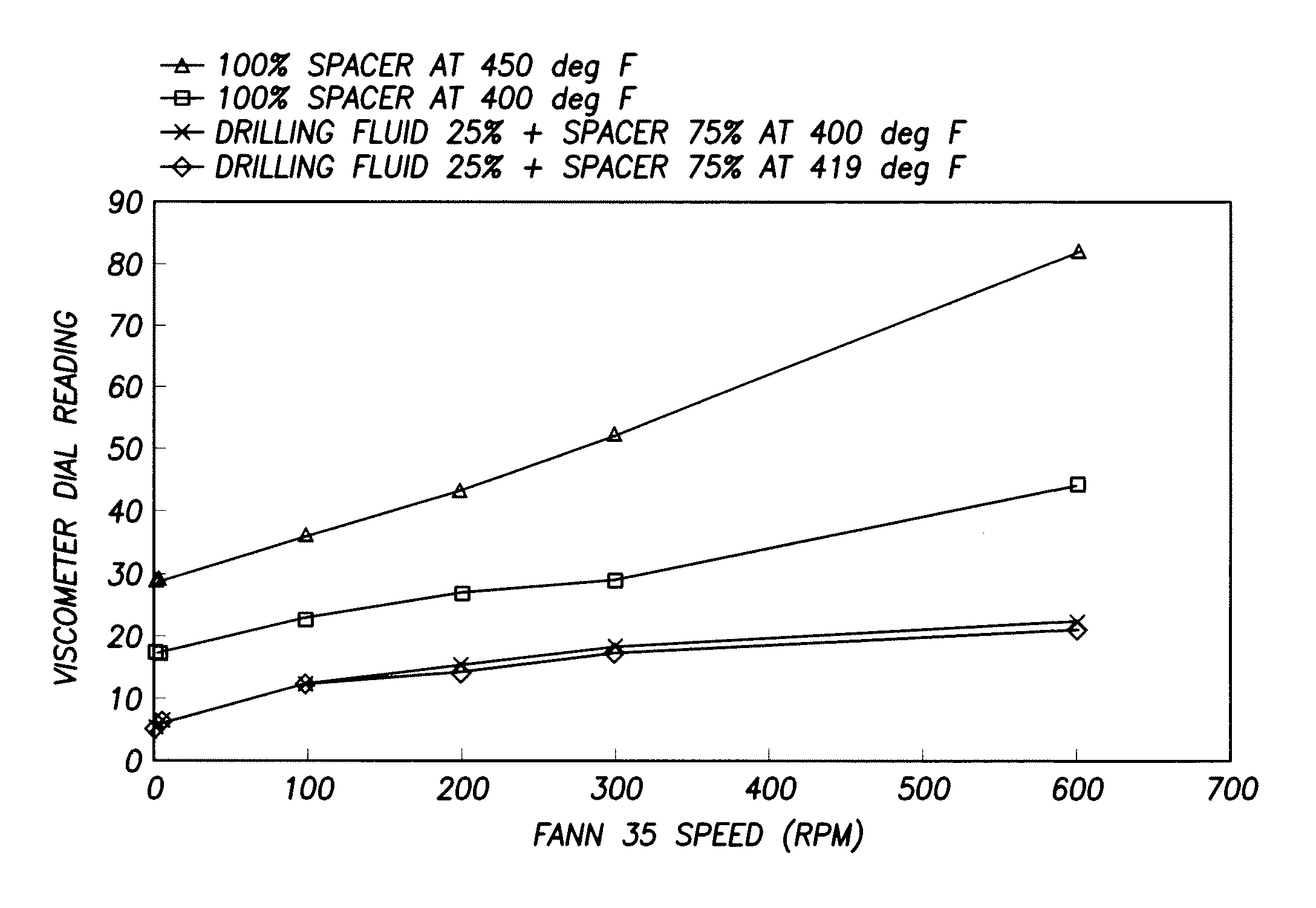Treatment Fluids Comprising Vitrified Shale and Methods of Using Such Fluids in Subterranean Formations
a technology of vitrified shale and treatment fluid, which is applied in the direction of sealing/packing, chemistry apparatus and processes, and wellbore/well accessories. it can solve the problems of premature reduction of the viscosity of the fluid, poor integrity of the bond between the cement and the formation, and the failure of the cement composition to satisfactorily bond to the casing string and/or the formation
- Summary
- Abstract
- Description
- Claims
- Application Information
AI Technical Summary
Problems solved by technology
Method used
Image
Examples
example 1
[0038]Rheological testing was performed on a variety of sample compositions that were prepared as follows:
[0039](1) Dry components (e.g., vitrified shale, or zeolite, or fumed silica) were mixed and dry additives, plus dry additives such as, for example, hydroxyethylcellulose, BIOZAN, and sodium lignosulfonate were weighed into a glass container having a clean lid, and thoroughly agitated by hand until well blended. Tap water then was weighed into a Waring blender jar, and the blender turned on at 4,000 rpm. While the blender continued to turn, citric acid was added to the mixing water, and then the blended dry components were added, followed by the Barite. The blender speed then was increased to 12,000 rpm for about 35 seconds. Afterwards, the blender was stopped, and about 2 drops of a standard, glycol-based defoamer were added.
[0040]Rheological values then were determined using a Fann Model 35 viscometer. Dial readings were recorded at speeds of 3, 6, 30, 60, 100, 200, 300, and 6...
example 2
[0053]Additional Rheological testing was carried out on several fluids having the following compositions.
[0054]Sample Composition No. 10, a well fluid of the present invention, comprised 60.98% fresh water by weight, 1.76% vitrified shale by weight, 36.22% barium sulfate by weight, 0.52% sepiolite by weight, 0.023% hydroxyethyl cellulose by weight, 0.044% BIOZAN by weight, 0.003% modified sodium lignosulfonate by weight, and 0.45% citric acid by weight.
[0055]Sample Composition No. 11 comprised 0.97% bentonite by weight, 27.79% silica flour by weight, 0.2% carboxymethyl hydroxyethyl cellulose by weight, 40.04% barium sulfate by weight, 0.37% by weight of sodium napthalene sulfonate condensed with formaldehyde, and 31.63% fresh water by weight.
[0056]Sample Composition No. 12 comprised 2.03% diatomaceous earth by weight, 1.82% coarse silica by weight, 0.1% attapulgite by weight, 0.63% sepiolite by weight, 0.52% by weight of sodium napthalene sulfonate condensed with formaldehyde, 0.1% ...
example 3
[0058]Additional Rheological testing was carried out using a Fann Model 75 viscometer. Dial readings were recorded at speeds of 3, 6, 100, 200, 300, and 600 RPM.
[0059]Sample Composition No. 13 was prepared as described in Table 6, below.
TABLE 6Sample Composition No. 13SpecificMassVolumeMaterialGravity(Kg)(Lit)wt %Water1298.5298.534.62TUNED SPACER ™ III blend2.510.04.001.16Barite4.2488.00115.3756.61Fe-21.542.001.300.23THERMA VIS ™110.0010.001.16Vitrified Shale2.6550.0018.875.8Bentonite2.653.001.130.35TAU MOD ™2.10.600.290.07Total862.10449.45Density (kg / lit)1.92Density (ppg)16.00
[0060]TUNED SPACER™ III blend is a water-based spacer fluid that comprises from about 60-80 weight % vitrified shale, from about 5-20% sepiolite, from about 5-20% diatomaceous earth (e.g., MN-51 (diatom)), and from about 1-10% BIOZAN. Thus, it provides vitrified shale and a mixture of viscosifying agents (sepiolite and diatomaceous earth and BIOZAN).
[0061]Sample Composition No. 13 was then tested for plastic v...
PUM
| Property | Measurement | Unit |
|---|---|---|
| temperatures | aaaaa | aaaaa |
| temperature | aaaaa | aaaaa |
| temperatures | aaaaa | aaaaa |
Abstract
Description
Claims
Application Information
 Login to View More
Login to View More - R&D
- Intellectual Property
- Life Sciences
- Materials
- Tech Scout
- Unparalleled Data Quality
- Higher Quality Content
- 60% Fewer Hallucinations
Browse by: Latest US Patents, China's latest patents, Technical Efficacy Thesaurus, Application Domain, Technology Topic, Popular Technical Reports.
© 2025 PatSnap. All rights reserved.Legal|Privacy policy|Modern Slavery Act Transparency Statement|Sitemap|About US| Contact US: help@patsnap.com



